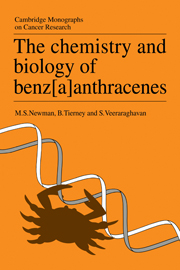Part 2 - BIOLOGY
Published online by Cambridge University Press: 07 September 2010
Summary
Historical aspects
With the onset of research into the carcinogenicity of pure chemicals, the benz[a]anthracene (BA) nucleus was regarded, in these early studies, as a basic requirement for the demonstration of carcinogenicity. Kennaway (1930) had observed that the application of a pure polycyclic aromatic hydrocarbon (PAH) to mice produces tumours. At the same time Hieger (1930) was investigating the fluorescence characteristics of particular fractions obtained from coal tar which possessed carcinogenic activity. The fluorescence spectra of these fractions were similar to the fluorescence spectrum of BA. These observations led investigators to propose that the ring system of BA, a compound which is only weakly carcinogenic in itself, provides the basis for a potentially carcinogenic molecule and that cancer-producing properties are developed by substitution at suitable positions (Barry et al., 1935).
Initially, because of the strong carcinogenic activity of 3-methylcholanthrene (3-MC) and dibenz[a,h]anthracene, substituents at positions 8 and 9 on the BA nucleus were regarded as particularly favourable for carcinogenicity (see figure). The chemical synthesis of a large number of compounds based on BA, which varied in the position, number and type of substituents, was undertaken in England by Cook and his associates at the Royal Free Hospital, London, and in the USA by Fieser and co-workers in Harvard and Newman at Ohio State University. The biological activities of these compounds were examined under the supervision of Kennaway in London and Shear in the USA.
- Type
- Chapter
- Information
- The Chemistry and Biology of Benz[a]anthracenes , pp. 83 - 86Publisher: Cambridge University PressPrint publication year: 1988



